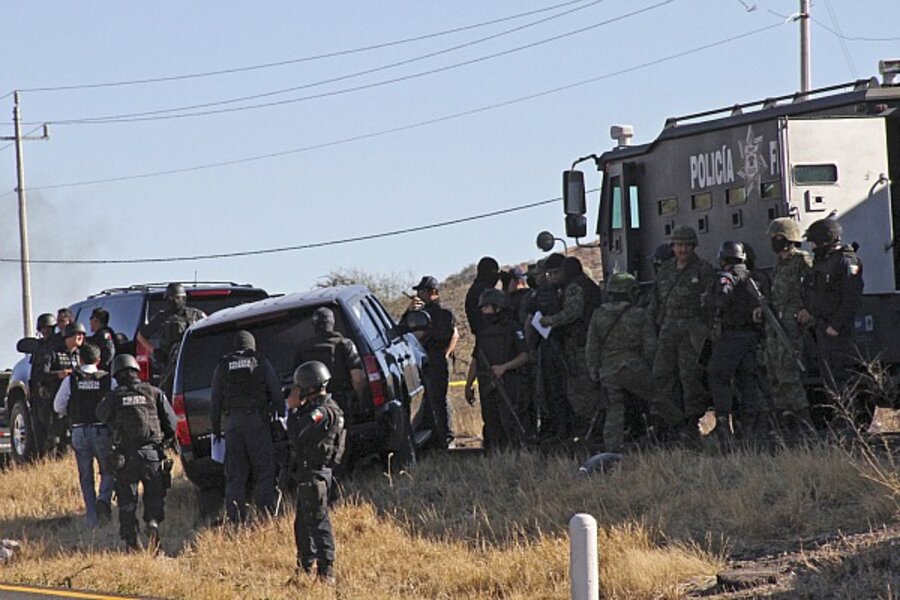Killing of US agent in Mexico could raise pressure on Mexico
Loading...
| Mexico City
A US federal agent was fatally shot Tuesday and another wounded in an attack on their vehicle that could raise pressure on Mexico to better protect US officials.
Jaime Zapata, who was working at the Immigration and Customs Enforcement (ICE) Attache office in Mexico City, died of his wounds. The injured agent, who was not identified, was shot in the arm and leg and remains in stable condition.
The special agents had been driving between the violent northern city of Monterrey and Mexico City through the state of San Luis Potosí when gunmen opened fire. Local media photos show a sports utility vehicle with tinted windows apparently run off the highway and peppered with bullets through the passenger window.
News reports that the men were caught in a false roadblock customarily set up by drug traffickers were not confirmed, and Mexican military told The Associated press that they have no checkpoints in the area.
The agents were shot in the line of duty. In response to an inquiry about the agents’ duties in Mexico, ICE said it coordinates investigations into “transnational criminal organizations” and serves as liaison with foreign law enforcement. ICE agents in Mexico also participate extensively in training of Mexican police, the US Embassy of Mexico City says.
On Tuesday, Mexico’s Foreign Ministry immediately condemned the attack and pledged to bring the assailants to justice. The same day, the Attorney General’s Office sent organized crime investigators to the relatively calm state of San Luis Potosí where the shooting took place, Mexican newspapers reported.
A tough US response?
Homeland Security Secretary Janet Napolitano said the United States is working closely with officials on the Mexican-led investigation to ensure the perpetrators are captured as quickly as possible.
“Let me be clear: Any act of violence against our ICE personnel ... is an attack against all those who serve our nation and put their lives at risk for our safety,” Ms. Napolitano said.
The strongly worded statement, along with a history of swift justice against the few traffickers who have killed or threatened US agents, portend a major crackdown against drug groups found responsible.
“You start killing US officials and that really turns up the heat,” says George Grayson, a Mexico expert at the College of William & Mary in Williamsburg, Virginia. “There’s going to be great pressure on the Mexican government to find out who was behind this killing, enormous pressure.”
Zapata’s murder is the highest profile killing of a US agent in Mexico since the abduction and torture of Drug Enforcement Agency (DEA) agent Enrique “Kiki” Camarena in 1985. In response, the United States launched the largest DEA homicide investigation ever undertaken, leading to the arrest of Miguel Ángel Félix Gallardo, the top drug kingpin in Mexico at the time. And the implication of Mexican officials in the murder brought US-Mexico relations to a boiling point.
Even a mere threat to US agents has been met with strong retaliation: Osiel Cárdenas, former head of the Gulf Cartel, had allegedly threatened to kill two US federal agents in 1999 in Tamaulipas. The Federal Bureau of Investigation offered $2 million for his arrest. He was captured in 2003 by the Mexican Army and eventually extradited to the United States on charges that included assaults on federal agents.
The US government temporarily shut the consulate in the violence-plagued border city of Ciudad Juarez in July citing a security review. And State Department banned travel after dark for government workers on some roads in Guadalajara earlier this month after traffickers blocked streets and set buses on fire. In March 2010, a US Consulate employee, her husband, and a third victim were gunned down in Ciudad Juárez, raising concerns.
Agents may now use more caution
If indeed the ICE agents were targeted by drug cartels on Tuesday, this could signal a more lethal stage of cartel violence, and US officials will likely be even more cautious about security, analysts say.
It was not immediately clear whether more alerts or travel restrictions would be placed on US officials, some of whom say they no longer take road trips into northern Mexican states.
A recently retired deputy director of ICE, Alonso Pena, told The Houston Chronicle that the ICE agents were apparently identifying themselves when the assailants opened fire with assault weapons. There is also some indication that the agents were traveling with diplomatic license plates, which may have identified them to the gunmen.
“To this day, the DEA and FBI have received threats, some of their informants have been killed, as have Mexican officers working with them, and the Sinaloa cartel even discussed using force against US officials and buildings in the US. But no [US] agents have actually been specifically targeted yet during the Calderón administration,” says Malcolm Beith, author of a book on the drug war “The Last Narco.”
“If they were targeted intentionally, then it’s a definite escalation,” Mr. Beith says.
Zapata, a native of Brownsville, Texas, was on assignment in Mexico City from his post in Laredo, Texas, The AP said. He’d joined ICE in 2006 and served on the Human Smuggling and Trafficking Unit and the Border Enforcement Security Task Force.





